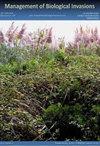No time to dye: dye-induced light differences mediate growth rates among invasive macrophytes
IF 1.2
4区 环境科学与生态学
Q3 BIODIVERSITY CONSERVATION
引用次数: 0
Abstract
Invasive, submerged macrophytes negatively alter aquatic ecosystems and biodiversity through disruption of ecological structure and functioning. These plants are especially challenging and costly to control, with relatively few successful eradications. We examine the efficacy of dye treatments to control three invasive, submerged macrophyte species: Elodea canadensis Michx., Elodea nuttallii (Planchon) H. St. John and Lagarosiphon major (Ridley). Using an experimental mesocosm approach, growth rates of each species were monitored in relation to five light treatment groups: light, 1×, 2×, 3× dye dosage, and complete darkness (range: 2 70 to 0 μmol·m -2 ·s -1 ). Dye presence did not negate growth in any of the tested species, but the effects of treatments on invasive macrophyte growth rates differed across species. In dyed conditions, E. canadensis exhibited significantly greater increases in length compared to E. nuttallii and L. major , whilst E. nuttallii and L. major were lower and statistically similar. However, L. major significantly increased length relative to Elodea spp. in dark conditions. Similarly, for biomass changes, Elodea spp. gained significantly more biomass than L. major under light and dyed conditions, but not in the dark. Our findings suggest that the tested dye concentrations are not sufficient to halt the growth of these plants. However, under certain conditions, they could potentially help to reduce densities of invasive macrophytes by slowing growth rates and reducing biomass in select species. Differential responses to light could also help explain species replacement dynamics under varying environmental contexts. Overall, while further empirical research is required, management actions that reduce light could help control aquatic macrophytes in combination with other actions, but could also simultaneously mediate shifts in community assembly.没有时间染色:染料诱导的光差异介导了入侵植物的生长速度
入侵的沉水植物通过破坏生态结构和功能,对水生生态系统和生物多样性产生负面影响。这些植物尤其具有挑战性,控制起来成本高昂,成功根除的案例相对较少。我们研究了染料处理对三种入侵的淹没植物的控制效果:加拿大绿叶藻。, Elodea nuttallii (Planchon) H. St. John和Lagarosiphon major (Ridley)。采用实验中观法,对5个光照处理组(光照、1x、2x、3x染料剂量和完全黑暗(范围:270 ~ 0 μmol·m -2·s -1)下各种属的生长速率进行了监测。染料的存在并没有抑制任何一种被试植物的生长,但处理对入侵性大型植物生长速率的影响在不同物种之间存在差异。在染色条件下,E. canadensis比E. nuttallii和L. major表现出更大的长度增长,而E. nuttallii和L. major则较低,统计学上相似。然而,在黑暗条件下,L. major相对于Elodea的长度显著增加。同样,对于生物量变化,Elodea sp .在光照和染色条件下获得的生物量显著高于L. major,而在黑暗条件下则没有。我们的研究结果表明,所测试的染料浓度不足以阻止这些植物的生长。然而,在某些条件下,它们可能通过减缓生长速度和减少某些物种的生物量来帮助降低入侵植物的密度。对光的不同反应也有助于解释不同环境下物种更替的动态。总体而言,虽然需要进一步的实证研究,但减少光照的管理行动可以帮助控制水生大型植物与其他行动相结合,但也可以同时调节群落聚集的变化。
本文章由计算机程序翻译,如有差异,请以英文原文为准。
求助全文
约1分钟内获得全文
求助全文
来源期刊

Management of Biological Invasions
Agricultural and Biological Sciences-Ecology, Evolution, Behavior and Systematics
CiteScore
3.40
自引率
6.70%
发文量
21
审稿时长
16 weeks
期刊介绍:
Management of Biological Invasions, established in 2010 by Dr. Elias Dana, is an open access, peer-reviewed international journal focusing on applied research in biological invasions in aquatic and terrestrial ecosystems from around the world. This journal is devoted to bridging the gap between scientific research and the use of science in decision-making, regulation and management in the area of invasive species introduction and biodiversity conservation.
Managing biological invasions is a crisis science, with Management of Biological Invasions aiming to provide insights to the issues, to document new forms of detection, measurements and analysis, and to document tangible solutions to this problem.
In addition to original research on applied issues, Management of Biological Invasions publishes technical reports on new management technologies of invasive species and also the proceedings of relevant international meetings. As a platform to encourage informed discussion on matters of national and international importance, we publish viewpoint papers that highlight emerging issues, showcase initiatives, and present opinions of leading researchers.
 求助内容:
求助内容: 应助结果提醒方式:
应助结果提醒方式:


